Putting on a mask is a transformative experience. It allows us to be someone we’re not for a moment, changing both how we see ourselves and how we behave outwardly. Many of us know this feeling from Halloween in America, but it’s a universal feeling shared across cultures throughout human history.
While some masked ceremonies have died out over the years, others cultures have held onto their traditions. Learn the meanings behind some of the most fascinating masks from around the world and find out where and when you can see them.
1. Venetian Carnival Masks
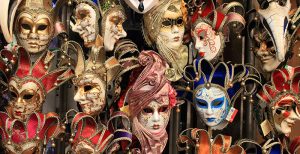
Worn during Carnival in Venice, these world-famous masks date back to the 13th century. The origin of the masks is unknown, but some theories suggest that they were donned in rebellion to the rigid society of the times. Venetian masks range in quality, size and material, from cheap papier mâché eye masks to porcelain face masks with long noses or elaborate feathers. Venetian masks were originally made by skilled craftsmen called the mascherari. Today they can be purchased as shops throughout Venice to wear during the 11 days of Carnival, which happen in January or February, depending on where Easter falls.
2. Mexican Day of the Dead Masks
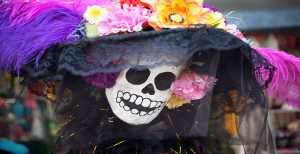
Dia de los Muertos masks represent calaveras, or skulls. The celebration originated as a way to honor the deceased and acknowledge death as a natural part of life. The festivities are on November 1st and 2nd throughout Mexico and Latin America, with celebrants wearing skull-shaped masks or face paint and colorful costumes and hats.
3. Chinese New Year Masks
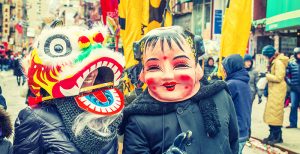
On the biggest holiday of the year in the most populous country in the world, various masks are worn during week-long celebrations to ring in the new year. Made from materials including stones, metal and leather, these colorful masks are designed to display the moods and emotions associated with the festival. The masks represent the deities, spirits and fabled animals that Chinese New Year mythology originated from.
4. Brazilian Carnival Masks
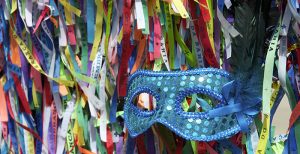
Similar in style to Venetian masks, Brazilian masks are also worn in celebration of Carnival during the week before lent. Their origins, though, are vastly different. Brazilian Carnival first occurred in the 17th or 18th century in Rio de Janeiro, but masks weren’t observed until the 19th century. Lower-class parading revelers, called Cordões, wore these masks in contrast to the more organized and lavish parades held by the aristocratic and working-class people. It’s the Cordões’ parties, where samba was also born, that the street parties in Carnival as we know them today more closely represent.
5. Filipino Dinagyang Masks
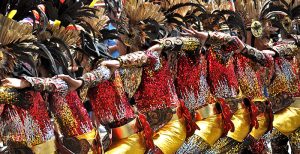
Celebrated in Iloilo City on the fourth weekend of January, Dinagyang revelers wear dazzling masks made of colorful materials, including feathers, beads and sequins. The festival brings music and dancing in the streets with participants wearing full-body costumes or body paint along with the exquisite masks.
6. African Festima Masks

Festima is the festival of all festivals for mask lovers. Officially dubbed the International Festival of Masks and Arts, Festima is a centuries old tradition celebrated in several West African countries, including the Ivory Coast, Senegal and Burkina Faso. Mask making is an ancient custom in Africa, and Festima is celebrated to protect the tradition. Festima masks made of wood, straw, leaves and textiles represent animals and ancestral spirits. Many locals believe that mask wearers embody the subject of the masks.
7. Bahamian Junkanoo Masks
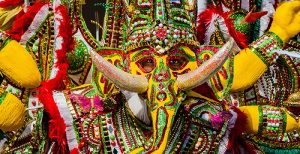
The origins of this festival may be hotly debated in the Bahamas, but one thing’s not debatable: Junkanoo masks are amongst the most ravishing in the world. Junkanoo masks range greatly in design, size and color, but they’re generally very colorful and part of a full-body costume. The masks are shown off in street parades during choreographed dances that last all evening on Boxing Day and New Year’s Day.
8. Austrian Krampusnacht Festival Masks
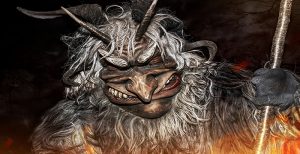
In parts of Austria, there’s a dark side to Christmas. Krampusnacht festival masks are based on their namesake, a mythical horned demon figure called Krampus. As folklore goes, Krampus contrasts St. Nicholas by punishing misbehaving children. In early December, Krampusnacht celebrators adorn handmade, wooden Krampus masks and goat or sheepskin suits to the dismay – or delight – of onlookers who are simultaneously celebrating St. Nicholas day.
9. Venezuelan Dancing Devils of Yare Masks
Diablos Danzantes, or dancing devils, are the theme of the masks worn in this festival celebrating the triumph of good over evil in the city of San Fransisco de Yare, outside of Caracas, Venezuela. Diablos Danzantes masks resemble winged dragons and vary in size based on how long a confradia, or group, has been participating in the festival. The masks, which have been worn since the 1700s, are meant to represent the confradia’s order in the devil’s hierarchy. They often take all year to craft by hand.
1o. Japanese Shimokita Tengu Matsuri Mask
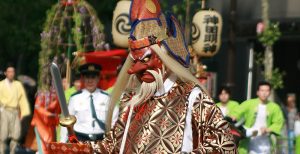
Shimokita Tengu Matsuri is also known as the long red-nosed goblins festival, which describes the design of the masks on parade floats and festival-goers alike. The long red nose on the mask is a portrayal of a bird’s beak, and the facial features resemble a human, following the mythological Tengu, a bird-like anthropomorphized creature in Japanese folklore. Shimokita Tengu Matsuri is held in Tokyo over three days in late January and early February. The festival centers around a parade, drum performance and the throwing of edible, roasted soy beans into the crowd.

